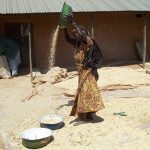来自美国哥伦比亚大学国际气候与社会研究所(IRI)、国际食物政策研究所(IFPRI)、宏观农业研究院(MARI)及其他合作单位的研究人员最新发现:厄尔尼诺-南方涛动现象(ENSO)是近年来导致全球各地同时出现农作物大规模歉收的原因。这一研究成果与全球农业体系的一个核心理念背道而驰;该理念假定,如美国、中国和阿根廷等地理位置遥远的产粮区之间的农作物歉收是不相关的。作者还提出了通过预测季节性气候来减少气候风险的可能性。 这项研究作为封面文章发表在《科学进展》(Science Advances) 期刊上,首次对ENSO等不同气候变异模式导致全球和地区玉米、小麦和大豆产量的波动程度做出了估计。例如,从1980年到2010年,这些气候变异导致全球玉米产量波动近18%。 国际气候与社会研究所博士后研究科学家、该论文第一作者Weston Anderson表示:“全球农业系统的稳定依赖于一种极大的可能性,即世界某个地区的低产量将被其他地区的高产量所弥补。” “当然,无论几率有多小,高产没能弥补低产的可能性总是存在的。”Anderson指出:“到目前为止,人们一直认为,大面积的农作物歉收来自于一系列随机的、灾害性天气事件。” Anderson和他的合著者们决定通过观察厄尔尼诺-南方涛动现象(ENSO)、印度洋偶极子(IOD)以及其他广为人知的气候模式对全球玉米、大豆和小麦产量的影响来验证这一观点。他们分析了这些气候变异模式是如何影响主要种植区的干旱和炎热情况。 Anderson说: “我们发现,ENSO能够并且已经迫使多个主要产粮区减产,包括1983年的重大减产。将风险集中起来作为一种缓解策略的问题在于,它假定减产是随机的。但我们知道,强厄尔尼诺(El Niño)或拉尼娜(La Niña)现象实际上决定了哪些地区经历干旱和极端气温。对一些作物来说,这种气候现象迫使多个主要产区同时减产。” 气候变异的影响有多严重?作者发现,在全球范围内,玉米是最容易受气候变异影响而歉收的作物;每年玉米产量变化的18%是气候变异的结果。研究还发现,大豆和小麦同时歉收的风险较小;气候变异导致的大豆和小麦减产分别仅占它们全球总产量变化的7%和6%。 “气候驱动因素的不确定性越大,食物系统参与者受的风险就越大。”本研究的合著者之一、IFPRI高级研究员游良志说:“受影响最严重的是发展中国家的贫困农民,他们的生计依赖于农作物产量;在正式保险产品或其他应对机制缺位的情况下,这些农民无法承担风险。”发展中国家由缺乏基础设施和资源带来的挑战更进一步加剧了这一风险。 Anderson说: “ENSO可能并非在所有年份都很重要,但它是我们所知道的唯一一个迫使全球各地同时出现作物大规模歉收的气候因素。” 在特定地区,气候变异给农业带来的风险可能更高。例如,在非洲大部分地区和巴西东北部,食物产量起伏的40%-65%是由ENSO和其他反复出现的气候现象导致的。在其他地区,这个数字低至10%。 虽然从表面上看,这似乎意味着那些受ENSO和其他气候模式影响更大的地区更容易发生极端事件,但这些数字实际上反映了那些地区同气候模式之间的联系是可以被监测和预测的。哥伦比亚大学拉蒙特·多尔蒂地球观测站(Lamont Doherty Earth Observatory)的Richard Seager是这篇论文合著者之一。他说:“这项研究让我感到兴奋的是,它展示了气候变异的可预测模式是如何影响多个地区的农作物生产,并且扩大到影响全球农作物生产。这项研究应该会让人们预期全球食物价格和供应受到的冲击,从而努力改善食物安全,并在需要时提供紧急食物援助。” 点击链接阅读论文全文(英) 国际气候与社会研究所(IRI)是哥伦比亚大学地球研究所的一部分,旨在提高社会理解、预测和管理气候影响的能力,以改善人类、特别是发展中国家居民的福利和环境。 国际食物政策研究所(IFPRI)寻求消除饥饿和贫困的可持续解决方案。IFPRI 成立于 1975 年,旨在确定和分析替代性的国家和国际战略和政策,以满足发展中国家的食物需求,尤其关注低收入国家和地区以及这些国家和地区的贫困群体。 宏观农业研究院(Macro Agriculture Research Institute,简称MARI)是华中农业大学与国际食物政策研究所共同建立的一个国际化的跨学科研究机构,立志建设成为一个高水平、具有国际影响力的科研平台以及特色鲜明、视野宽广的新型农业智库。 Source: 国际食物政策研究所北京 中国项目
Biofortified staples may hold the key to India’s rural malnutrition
The National elections in India may well be over, but the persistent issue of malnutrition still holds the nation in its tight grip. And yet, of the myriads of topical issues that comprised political propaganda, including caste, religion, employment, farmer upliftment, and even social transfers, none of the political parties raised this critical issue. The twin problems of malnutrition and nutritional insecurity are particularly severe in rural India. Source: IFPRI South Asia Office
What’s the future of food subsidies in Egypt?
Hoda El-Enbaby and Clemens Breisinger - IFPRI
In Egypt’s current context of wide-ranging economic reforms, there is growing momentum to improve the longstanding Tamween food subsidy system. Tamween’s ration cards benefit around 70 million people, while the bread subsidy benefits around 83 million people, and together they make up about 6 percent of the government’s budget. During a workshop organized by the World Bank under the auspices of the Ministry of Supply and Internal Trade (MoSIT), on May 20th, 2019, Marina Wes (World Bank Country Director for Egypt, Yemen and Djibouti) emphasized the potential expected gains of reforming the subsidy program, and the importance of learning from other countries while contextualizing to Egypt-specific conditions. Source: IFPRI Egypt Country Office
The Women’s Empowerment in Agriculture Index – What have we learned?
Women are key to rural revitalization in developing countries, but various constraints and obstacles limit their contributions to their households and communities. During our research seminar on June 12, Elena Martinez and Emily Myers, Research Analysts at IFPRI, Washington DC, presented the Women’s Empowerment in Agriculture Index (WEAI) and its modifications as tools that quantify >> Read more Source: Malawi Strategy Support Program
Measuring and reducing food loss in developing countries
This blog is cross-posted from the IFPRI website and was originally written by Swati Malhotra. The amount of food loss and waste in supply chains is significant. The most widely cited estimate, by the UN Food and Agriculture Organization (FAO), is that as much as one third of total usable global food production is not >> Read more Source: Malawi Strategy Support Program
- « Previous Page
- 1
- …
- 59
- 60
- 61
- 62
- 63
- …
- 75
- Next Page »




